Books - Read and Enjoyed
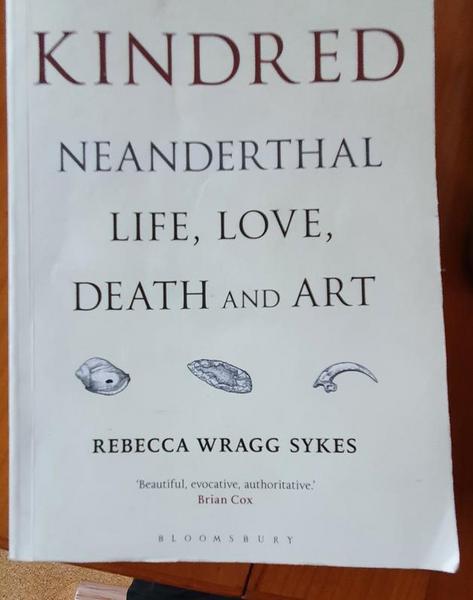
Kindred
Neanderthal Life, Love, Death and Art
Rebecca Wragg Sykes
Bloomsbury Sigma 2021
The origin of Homo Sapiens continues to fascinate, not least because there are so many things still unknown. The evolutionary lineage of humans split from gibbons ca 20 Ma (Million years ago), from orangutans, ca 17 Ma, from gorillas ca 10 Ma, and from chimpanzees and bonobos ca 5 Ma. We do not know how many hominin species have existed, but we have identified remains of 28 different species. Neanderthals split from the H. Sapiens lineage ca 800 ka (thousand years) ago. They may have developed in Europe as no Neanderthal fossil has been found in Africa or east of the Altai mountains. In Atapuerca, Northern Spain, fossils of a the earliest “Proto-Neanderthals” have been found and dated around 450-430 ka.
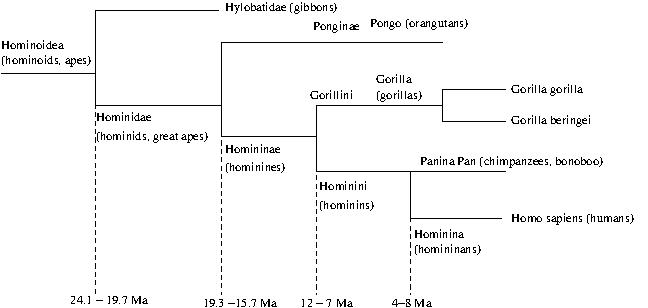
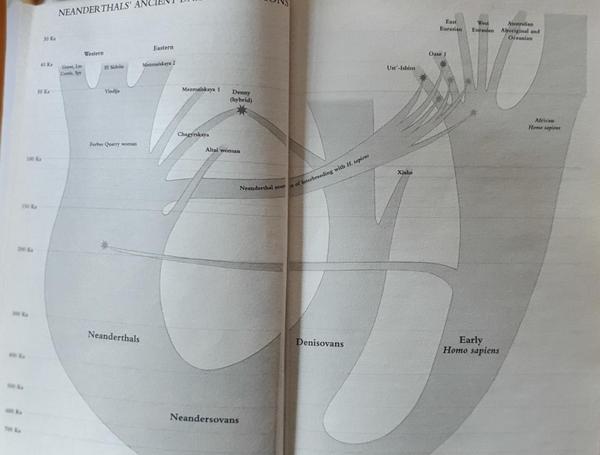
Denisova hominins are the Asian counterpart to the European Neanderthals, but compared to the rather rich set of Neanderthal fossils, we have found only few bones and teeth from Denisovans. Indeed, only in 2010 the first Denisovan individual has been identified, based on mitochondrial DNA extracted from a juvenile female finger bone excavated from the Siberian Denisova Cave in the Altai Mountains in 2008. Thus, the very recent technique of DNA analysis was instrumental in identifying the Denisovan species.
Denisovans and Neanderthals are slightly closer related to each other than to humans. The homo sapiens lineage has split from the Neanderthal-Denisovan lineage around 800 ka, and the latter split again shortly thereafter. But all three lineages have repeatedly interbreeded and mixed their genome. That this was not a very exceptional event is suggested by the astonishing find from 2012 in the Denisova cave in the Altai mountains of today’s Russia. A bone fragment from a leg or arm of 13 year old adolescent female has been identified as a first generation hybrid with a Denisovan father and a Neanderthal mother (Denisova 11, nicknamed “Denny”), dated to be between 80 ka and 118 ka old. Another Denisovan fossil has been found with the trace of interbreeding from 4-6 generations earlier. While Neanderthals have been European, Denisovans have been Asian. Today humans with the highest amount of Denisovan DNA are Aboriginal Australians, Near Oceanians, Polynesians, Fijians, Eastern Indonesians and Mamanwans (from the Philippines), but not East Asians. This suggests that interbreeding mostly occurred in the Pacific region but not mainland Asia.
Analysis of ancient DNA during the last 15 years have provided amazing new insights into the evolutionary history, but there are still many uncertainties because of the unknown precise mutation rate, the very limited amount of fossils and DNA available and the possibility of several scenarios that could explain the data we observe.

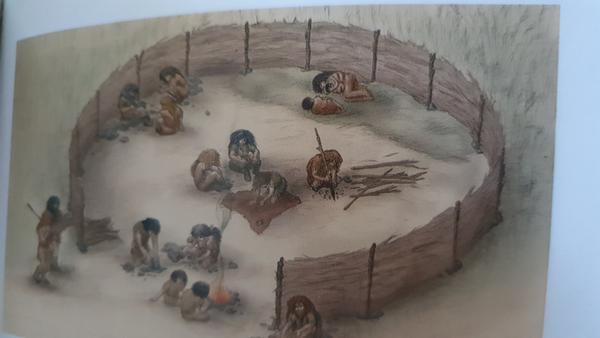
Techniques Used in Archaeology
The archaeological techniques and methods have tremendously developed during the last decades, giving us new insights into materials used, tools manufactured, body anatomy and lifestyles.
Chemical analysis of bones and teeth tell us among other things, how long Neanderthals have been breastfeeding (as long as we do), what they ate (see picture) and what they did not eat, how long they lived after a bone fracture (sometimes very long which suggests support by others in the group), and many other fascinating details.
Microscopic analysis shows the micro wear on teeth and bones (animal and Neanderthal bones). From that we know, that they worked animal hides with their teeth and that 80% were right handed, which in turn tells us something about the asymmetricity of their brains, suggesting that the Neanderthal brain organization was probably rather similar to our own. From that and their societal organization we assume, that Neanderthals had language, but we do not know if it was as sophisticated as our own or much simpler.
The analysis of stone tools and the waste material of Neanderthal hearths has developed enormously leading to a very detailed understanding of the tools they used and how they manufactured them.
3-D reconstruction of a stone tool and all the splinters found in the waste makes it possible to reconstruct the manufacturing process: which splinter has been knapped off in which order. Also the speed and force to knapp off a particular splinter can be derived together with the tool used, such as a bone or another stone. This leads to a 4-D reconstruction of the manufacturing and means we know in great detail the manufacturing process of a tool: how long it took, which techniques have been used, which forces have been applied.
Also, the source of the material and tools found in particular places could often be identified. This tells us, how far Neanderthals moved around, how long they used their tools, which material and tools were considered most valuable, which tools and materials have been repaired and repurposed how many times. The chemical analysis of the stones tell us that Neanderthals have used colors, in particular ochre, red and black. Almost certainly they have also manufactured some devices for ornamental and artistic purposes. To let R. W. Sykes comment one such find:
Thw single object sparked a cascade of scenarios, all imagined
but archeologically supported. Sometime around 46 ka, a
Neanderthal noticed stone shells eroding from limestone, and
picked one up. She carried this tiny piece from place to place;
kept it so long its surface became polished. Her fingeres pressed
in special red colour, leaving a stain on her skin. Eventually,
one day it dropped from its usual place - folded in or tied into
leather - and unknowingly or not, she left it behind in the
mountains.
Had the shell been excavated from an early H. sapiens site, seeing
this as symbolic brhaviour would be uncontroversial. Whether it
had practical as well as aestetic use, it was unarguably precious.
(page 254)
Determining the age of found artifacts is crucial for classifying and contextualizing finds. A number of chemical dating techniques have been developed.
-
Radiocarbon dating: The most common carbon isotop has 6 protons and 6 neurons in its nucleus, called 12C. 14C is a carbon isotope with two additional neutrons, which has exactly the same chemical properties, but it is not stable. It spontaneously decays into nitrogen 14N, when one neutron is transformed into a proton. That transformation occurs spontaneously and is independent of the temperate and the chemical environment but follows a simple exponential decay law with a half-life of 5730 years. This means that after 5730 years half of the 14C atoms have transformed themselves into 14N atoms.
This process can be used for dating organic material because during the lifetime of a creature 14C and 12C atoms will be used in the exact proportion as it is available in the atmosphere. After the death of the animal (or the human or the Neanderthal) the bones do not uptake new 14C atoms. That means that after 5730 years half of the 14C atoms are transformed into 14N atoms, and the relative proportion of 14C and 14N atoms tells us, when the animal has lived. If we find as much 14C as 14N, the animal has lived around 5730 years ago; if the relation of 14C to 14N is 1:1024, then the animal has live round 57300 years ago, because 210=1024.
This method works well for dating organic material up to 60 ka ago; after that the amount of 14C is often too small to be determined with sufficient accuracy. The main problem of the method is contamination of the material to be studied.
-
Amino acid dating: All biological tissues contain amino acids. All amino acids except glycine can have two different configurations: “D” and “L”, which are mirror images of each other. With few exceptions, all living organisms keep their amino acids in the “L” configuration. But when the organism dies, control over the configuration ceases and the ratio of “D” to “L” moves from near 0 to 1. Hence, measuring the ratio of “D” to “L” in a sample of organic material allows to estimate the time since the creature died.
However, this process is temperature dependent, which means it is important to know the historic temperature development of the site, where the organic artifact has been found. As a rule of thumb, sites with a mean annual temperature of 30 °C have a maximum range of 200 ka and resolution of about 10 ka; sites at 10 °C have a maximum age range of ~2 Ma, and resolution generally about 20% of the age; at -10 °C the reaction has a maximum age of ~10 Ma, and a correspondingly coarser resolution.
-
Potassium–argon dating is a techniue for inorganic minerals. It is based on the radioactive decay of an isotope of potassium (K) into argon (Ar), with a half-live of 1.248 billion years. Thus, it can be used to determine the time when a mineral has solidified and it can be applied to minerals more then 100 ka old. Although its direct applicatin to arheology is limited, it is used to bracket the age of deposit layers, where archaeological artefacts have been found. This is possible for instance, if the deposit layer of interest has lava flows above and below it. This technique is very helpful for finding reference dates of deposit layers from more than 100 ka up to many Ma.
Archaeologists go to great length to extract the last bit of information from an excavation site. Sykes describes one such case:
One last question: what did Neanderthals do with waste from their
own bodies? The hominin dung in a hearth at El Salt has already
been mentioned, and researchers took excavations here to a
Lilliputanian scale. Using a vacuum hose to filter sediment
down to 1mm, the hearth micro-stratigraphy was teased out. The
burned-black old occupation surfaces under the fire showed a
triple-phased structure, with concentrations of tiny lithics and
coprolite biomarkers more abundant at the top and bottom.
It looks like Neanderthals had first made a fire when arriving,
then swept the floor and burned the waste, which included old
faeces mixed animal dung and plant material. This feels like a
'deep clean' on moving into a home, but there's also evidence from
Abric Romani that bodily waste was routinely incinerated along
with grass and potentially moss: most likely old bedding.
(p 199)
Very detailed analysis of excavation sites reveal the organization of Neanderthal camps. Abric Romani, a site in north-eastern Spain at the feet of the Pyrenees has been studied to this end.
The more ancient Level Ob has been subject to full-spectrum
refitting, and - translated from dry scientific description -
the results are like a map allowing you to imaging dawn in a
Neanderthal home 55,000 years ago, just after its occupants have
left. Standing back against the rear wall, look down and your
feet are surrounded by smashed-up teeth, jaws and possibly
skulls. The stone hammers and anvils that processed deer, horse
and aurochs still lie there. Straight in front of you, wisps of
smoke rise from a large bonfire, in its ancient sense: fuelled by
intensely burned butchery trash, obviously reused many times.
As the sun rises to your right, it picks out a roughly circular
mass of thousands of lithics and bone fragments: splittered
ditritus from final butchery stages, plus more hammers. A greasy
smell suggests that cooking happened here too. The ground is
compressed: many feet have walked here, tired legs folded to sit,
and where children poked the ground with sticks, there are small
pieces of bone pressed down into underlying deposits. Look
to the rockshelter's margins: the ground is comparatively clear,
but things have still been happening, and at the western side
there's the still bloodied skeleton of a cat, dragged spitting
from its tree under last night's moon.
Seeing such detail in how Neanderthals separated this space is
remarkable [...] Even being conservative, the cumulative
patterns point to at least two areas around here being active at
the same time.
(p 194)
But the highest definition [in time] yet achieved for any
Neanderthal site comes from another rockshelter less than 5km
south-west [of the El Salt unit in eastern Spain]. Since 2005,
excavations at Abrice del Pastor have uncovered the entire
60m2 surface, so we can be sure no hearths are
unaccounted for. In Level IV, which is only 70cm thick, at least
four sub-levels contain more than one occupation
phase. Crucially, some phases have miniscule assemblages
clustered around a single fire: IVc-1 even has more animal bone
fragments (95) than lithics (22), which form just 6 RMUs [Raw
Material Unit]. This particular phase looks exactly like the
ephemeral trace of a few Neanderthals staying one night, doing a
bit of knapping, eating, then moving on.
(p 191)
What we know of their bodies and minds:
Neanderthal bodies were pretty similar to ours. They were a bit smaller and stronger. They were walking a lot, probably many kilometers every day on average. They were not as good runners as we are, but had more force in their arms. There are speculations about differences in the brain, but these are just that: speculations. It is safe to assume that they had language, but if it was as complex as or simpler than our own, we have no clue. Around 80% were right handed, which we know from the wear on their teeth.
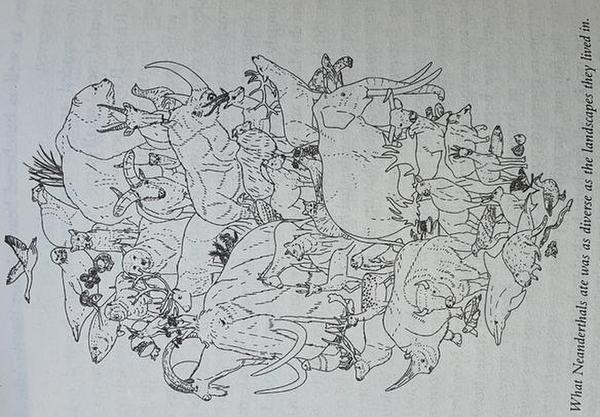
Genetics
Due to 3-6 interbreeding periods all modern humans, except those of sub-Saharan origin, have Neanderthal genes: between 1.7-2.6%. Western Europeans have the lowest proportion (<2%) and Indigenous Americans, Asians and Oceaneans have more (>=2.2%). Not everybody has the same set of genes and altogether 20% of the Neanderthal genome is still present in humans. From that perspective, Neanderthals are not completely but only 80% extinct.
Neanderthals’ genome was less diverse than humans and also less diverse than Denisovans. This means that they were probably living in bands of 10-50 individuals with less frequent interchange between bands, than comparable human groups had.
Extinction
Several theories about the cause of extinction have been put forward. Among them are climate change, strong competition by homo sapiens, and diseases. But none of these theories can be substantiated by strong evidence.
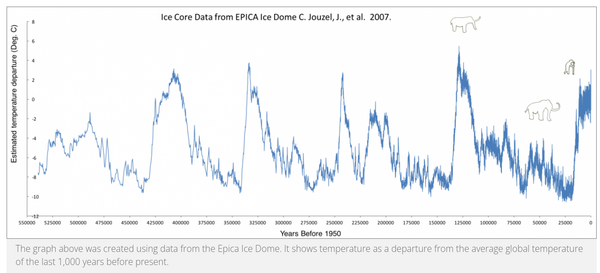
Consider climate change. Neanderthals have lived for 600 ka, a period which has seen very significant changes of the climate. Neanderthals went extinct around 40 ka ago. During that time the climate became gradually colder, being around 7 °C colder than today. But during the whole period when Neanderthals lived this was no exception. In fact this was rather the norm with periods that were 2 °C colder still and at some times the climate was up to 3 °C warmer than today. Thus, Neanderthals have survived several dramatic climate changes and there is no explanation, why the last one should have been particularly devastating.
A similar argument can be given regardiing the competition with homo sapiens. During their whole period of their existence, Neanderthals have coexisted and competed with other hominins, and they have several times interbreeded with each other. We have no evidence that around 40 ka ago this competition has become more severe.
It should also be noted, that non-continuation of lineages of hominins was rather the norm than the exception. For instance, living Europeans did not descend from any of the H. sapiens living in Europe at the time of the Neanderthals, but they have been replaced by later migrants. So, not only the Neanderthals but all homo sapiens that lived around 50 ka in Europe have discontinued and been replaced by new immigrants.
Neanderthals continue to fascinate us and the book by Rebecca Wragg Sykes is a comprehensive and accessible summary of what we today know of our cousins, who are not quite extinct. By paying attention to details and by often extensively discussing the arguments for and against a particular hypothesis, the book gives lively insight into the developing knowledge about Neanderthals. It shows how quickly archaeology progresses and how much more we know today compared to 15 or 20 years ago. In particular DNA analysis has opened up new avenues that will take years to explore. Hence, in the coming years we can expect the emergence of new, exciting insights into the Neanderthals’, and our own, past.
(AJ August 2022)
